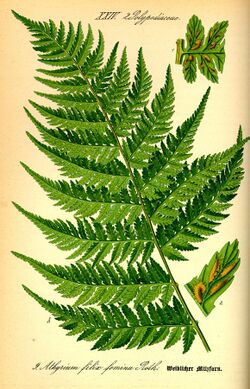Biology:Athyrioideae
| Athyrioideae | |
|---|---|

| |
| Athyrium filix-femina | |
| Scientific classification | |
| Kingdom: | |
| (unranked): | |
| Subclass: | |
| Order: | |
| Family: | |
| Subfamily: | Athyrioideae B.K.Nayar
|
| Type genus | |
| Athyrium | |
| Genera | |
|
See text | |
Athyrioideae is a subfamily of terrestrial ferns, with a cosmopolitan distribution.
Taxonomy
Earlier classifications
Previously treated as a separate family, Athyriaceae Alston,[1][2] in 2014 Christenhusz and Chase submerged it as subfamily Athyrioideae within family Aspleniaceae.[3]
Originally considered as a member of the Eupolypods II clade, the Athyriaceae was related to other families in the clade as in this cladogram:[4][5]
The Athyriaceae in the past included Cystopteris and Gymnocarpium, now part of Cystopteridaceae. Inversely, this family has by some been subsumed in the family Woodsiaceae, but a Woodsiaceae defined in this way may be paraphyletic if it omits the Onocleaceae and Blechnaceae (as of 2006, the evidence was not clear).[2]
Christenhusz and Chase classification
Athyrioideae is placed within the Aspleniaceae as follows:[3]
| Aspleniaceae |
| ||||||||||||||||||||||||||||||||||||||||||
Subdivision
Athyrioideae contain the following five genera.[1]
with the following phylogenetic relationship: [6][7]
| Athyriaceae |
| ||||||||||||||||||||||||||||||||||||||||||
References
- ↑ 1.0 1.1 Maarten J. M. Christenhusz, Xian-Chun Zhang & Harald Schneider (2011). "A linear sequence of extant families and genera of lycophytes and ferns". Phytotaxa 19: 7–54. http://www.mapress.com/phytotaxa/content/2011/f/pt00019p054.pdf.
- ↑ 2.0 2.1 Alan R. Smith; Kathleen M. Pryer; Eric Schuettpelz; Petra Korall; Harald Schneider; Paul G. Wolf (2006). "A classification for extant ferns". Taxon 55 (3): 705–731. doi:10.2307/25065646. Archived from the original on 2008-02-26. https://web.archive.org/web/20080226232147/http://www.pryerlab.net/publication/fichier749.pdf.
- ↑ 3.0 3.1 Christenhusz, Maarten J.M.; Chase, Mark W. (2014). "Trends and concepts in fern classification". Annals of Botany 113 (9): 571–594. doi:10.1093/aob/mct299. PMID 24532607.
- ↑ Samuli Lehtonen (2011). "Towards Resolving the Complete Fern Tree of Life". PLoS ONE 6 (10): e24851. doi:10.1371/journal.pone.0024851. PMID 22022365. PMC 3192703. http://www.sci.utu.fi/sivustot/amazon/publications/articles/pdf_pub/Lehtonen_2011_PLoS1.pdf.
- ↑ Carl J. Rothfels; Anders Larsson; Li-Yaung Kuo; Petra Korall; Wen- Liang Chiou; Kathleen M. Pryer (2012). "Overcoming Deep Roots, Fast Rates, and Short Internodes to Resolve the Ancient Rapid Radiation of Eupolypod II Ferns". Systematic Biology 61 (1): 70. doi:10.1093/sysbio/sys001. PMID 22223449. http://sysbio.oxfordjournals.org/content/early/2012/01/04/sysbio.sys001.short?rss=1.
- ↑ Eric Schuettpelz; Kathleen M. Pryer (2007). "Fern phylogeny inferred from 400 leptosporangiate species and three plastid genes". Taxon 56 (4): 1037–1050. doi:10.2307/25065903. Archived from the original on 2012-04-30. https://web.archive.org/web/20120430050757/http://people.uncw.edu/schuettpelze/fernlab/publications_files/schuettpelz_and_pryer_2007.pdf.
- ↑ Yea-Chen Liu, Wen-Liang Chiou; Masahiro Kato (2011). "Molecular phylogeny and taxonomy of the fern genus Anisocampium (Athyriaceae)". Taxon 60 (3): 824–830. http://140.130.96.119/wordpress/wp-content/uploads/2011/06/Taxon-60-824-830-Anisocampium.pdf.
Wikidata ☰ Q3774137 entry

